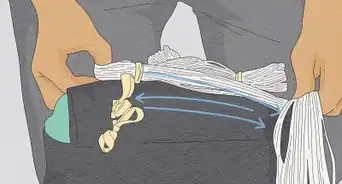This article was co-authored by wikiHow Staff. Our trained team of editors and researchers validate articles for accuracy and comprehensiveness. wikiHow's Content Management Team carefully monitors the work from our editorial staff to ensure that each article is backed by trusted research and meets our high quality standards.
wikiHow marks an article as reader-approved once it receives enough positive feedback. In this case, 93% of readers who voted found the article helpful, earning it our reader-approved status.
This article has been viewed 203,137 times.
Learn more...
Riding jet skis in the summertime can be an absolute blast. In order to ensure that next summer will be as fun as the one that's recently passed, you'll need to winterize your jet ski properly. Otherwise, your jet ski may become damaged and/or fail to run. Winterize your jet ski by draining it, cleaning it, filling it with gas, lubricating it, and storing it correctly.
Steps
Draining Your Jet Ski
-
1Remove your jet ski from the water. When you're done with the last ride of the season, get your jet ski out of the water as soon as possible. With your trailer securely attached to the back of your vehicle, slowly back your vehicle down the ramp until most of the trailer is underwater. Then get onto your jet ski, drive it up onto the trailer, and hook it to the trailer. Get back into your vehicle and slowly drive forward to safely remove the jet ski from the water.[1]
- If possible, have a friend assist you with this so that one of you can drive the vehicle and the other can drive the jet ski.
-
2Reposition the jet ski for draining. The bow (front) needs to be higher than the stern (rear) of your jet ski so it can be drained properly. Secure your jet ski on the trailer so that the back of it is lower than the front.[2]Advertisement
-
3Turn the throttle back and forth to drain the water. Turn the jet ski on and alternate between moving the throttle back and forth in short bursts. Do this in 30 second intervals to prevent overheating.[3] Continue this until water is no longer being expelled from the jet ski.
-
4Mix water and antifreeze in a bucket. Use RV antifreeze only! It is much less harmful to the environment. Do not use regular automotive antifreeze. The antifreeze will prevent any fluids from freezing in the exhaust system while the jet ski is stored. Mix one gallon (3.8 L) of RV antifreeze and one gallon (3.8 L) of water in a five gallon (18.9 L) bucket.[4]
-
5Flush the mixture through the exhaust system. Hook a hose or water pump up to the flush outlet while keeping the other end submerged in the antifreeze mixture. Turn the engine on and off once the entire mixture has gone through the exhaust system.[5]
Cleaning, Gassing Up, and Lubricating Your Jet Ski
-
1Wash the exterior with car safe soap. Fill a bucket with warm water and add in a few squirts of car safe soap. Soak a scratch-free cloth in the soapy water and wipe down the exterior of your jet ski with it. Pay close attention to the bottom of the jet ski, where algae and slime tend to accumulate.[6]
- Don't use dishwashing liquid or hand soap.
-
2Rinse and dry your jet ski. Thoroughly rinse off your jet ski with clean water. You can do this with a hose or by filling and dumping buckets of water onto the jet ski. Afterwards, let the jet ski air dry completely.
- If you want to, you can then use a high-shine protectant car wax to buff and shine your jet ski.[7]
-
3Put stabilizer in your gas tank. Get a bottle of fuel stabilizer and add it to your gas tank as the product label instructs.[8] This will prevent fuel contamination and will also keep residue from building up in the carburetor, fuel injection system, and gas lines.
-
4
-
5Lubricate your jet ski's moving parts. Spray lubricant on the areas of your jet ski that are often rotating and turning. Some of these areas include the steering nozzle pivot points, the reverse mechanisms, and the brake mechanisms.
- It's also a good idea to spray the engine as well as the electrical components to rid them of any traces of water.[11]
Storing Your Jet Ski
-
1
-
2
-
3Store your jet ski in a secure garage. It's ideal to store your jet ski on its trailer in a garage, but you can also store it in a shed, a barn, or outside. Remove the tires from the trailer or put blocks of wood underneath them to prevent dry rot and corrosion.
- Remember to keep your jet ski stored away from any flammable substances, since it's full of gas.[16]
-
4Cover your jet ski. Either cover your jet ski with a tarp or cover to keep it protected. Also plug the exhaust outlets and air intakes with rags to keep rodents from getting inside the jet ski.
- If you store your jet ski in a shed, a barn, or outside, it's important to protect the jet ski a little more. Cover it with a second tarp or cover.
Community Q&A
-
QuestionDo I need to winterize if it was summerized but never went in the water?
 Neil Rutiger WhiteCommunity AnswerIf the engine is liquid-cooed, get a hydrometer and check the strength of the antifreeze/coolant. If it needs to be drained, just the drain cock on the rad would be enough, then top it off with the proper coolant.
Neil Rutiger WhiteCommunity AnswerIf the engine is liquid-cooed, get a hydrometer and check the strength of the antifreeze/coolant. If it needs to be drained, just the drain cock on the rad would be enough, then top it off with the proper coolant.
Warnings
- Never run the jet ski engine for more than 30 seconds when it is out of the water.⧼thumbs_response⧽
- Do not store your jet ski in the house. It emits hazardous fumes.⧼thumbs_response⧽
Things You'll Need
- Jet ski trailer (and vehicle to pull it)
- Antifreeze
- Bucket
- Water
- Hose or water pump
- Care safe soap
- Scratch-free cloth
- High-shine protectant car wash
- Fuel stabilizer
- Premium gas
- Lubricant spray
- Automatic battery charger
- Safe storage area
- Cover or tarp
- Wooden blocks (optional)
- Rags
References
- ↑ https://blog.sea-doo.com/tag/launching-your-jetski/
- ↑ http://blog.extraspace.com/2014/09/22/6-tips-keep-jet-ski-free-winter-damage/
- ↑ http://blog.extraspace.com/2014/09/22/6-tips-keep-jet-ski-free-winter-damage/
- ↑ https://blog.sea-doo.com/2013/11/13/how-to-winterizing-your-sea-doo-watercraft/
- ↑ https://blog.sea-doo.com/2013/11/13/how-to-winterizing-your-sea-doo-watercraft/
- ↑ http://blog.extraspace.com/2014/09/22/6-tips-keep-jet-ski-free-winter-damage/
- ↑ http://blog.extraspace.com/2014/09/22/6-tips-keep-jet-ski-free-winter-damage/
- ↑ http://blog.extraspace.com/2014/09/22/6-tips-keep-jet-ski-free-winter-damage/
- ↑ https://blog.sea-doo.com/2013/11/13/how-to-winterizing-your-sea-doo-watercraft/
- ↑ http://www.jetski.com/article_cfm_id=686.html
- ↑ https://blog.sea-doo.com/2013/11/13/how-to-winterizing-your-sea-doo-watercraft/
- ↑ https://blog.sea-doo.com/2013/11/13/how-to-winterizing-your-sea-doo-watercraft/
- ↑ https://itstillruns.com/winterize-yamaha-waverunners-5800873.html
- ↑ https://blog.sea-doo.com/2013/11/13/how-to-winterizing-your-sea-doo-watercraft/
- ↑ http://www.batteryweb.com/jet-ski-batteries.cfm
- ↑ http://blog.extraspace.com/2014/09/22/6-tips-keep-jet-ski-free-winter-damage/
About This Article
To winterize a jet ski, start by removing it from the water and making sure the stern is higher than the bow so it can be drained. Next, turn the throttle back and forth to drain the water. Once it’s fully drained, mix water and antifreeze in a bucket and flush the mixture through the exhaust system. Then, wash the exterior with car-safe soap, rinse the jet ski with water, and let it air dry. Additionally, add fuel stabilizer to your gas tank to prevent residue from building up, then top the tank off with gas to keep condensation from forming. To learn how to store your jet ski after cleaning it, keep reading!











































































